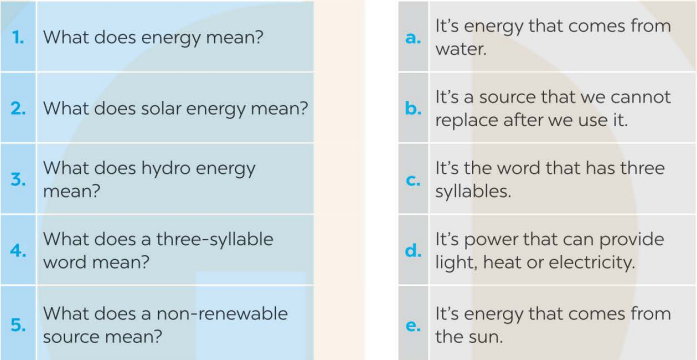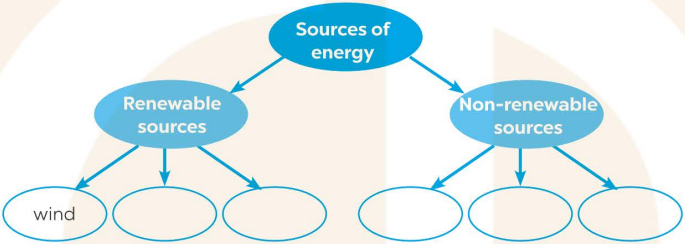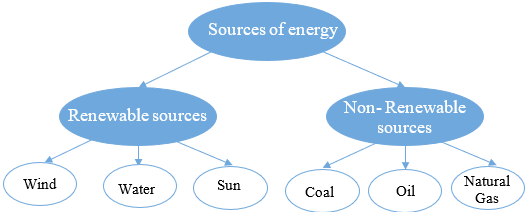Speaking - Unit 10: Energy Sources - SBT Tiếng Anh 7 Global Success1. Match the questions with the answers. Then say them aloud. 2. Mi and Tony are talking about energy sources. Choose the sentences (a-e) to fill in the gaps (1-5) of the conversation. 3. Complete the chart. Then ask and answer the questions about advantages and disadvantages of renewable and non-renewable sources. Tổng hợp đề thi học kì 1 lớp 7 tất cả các môn - Kết nối tri thức Toán - Văn - Anh - Khoa học tự nhiên... Quảng cáo
Lựa chọn câu để xem lời giải nhanh hơn
Bài 1 1. Match the questions with the answers. Then say them aloud. (Nối câu hỏi với câu trả lời. Sau đó đọc to chúng.)
Lời giải chi tiết:
1 - d: What does energy mean? - It’s power that can provide light, heat or electricity. (Năng lượng có nghĩa là gì? - Đó là năng lượng có thể cung cấp ánh sáng, nhiệt hoặc điện.) 2 - e: What does solar energy mean? - It’s energy that comes from the sun. (Năng lượng mặt trời có nghĩa là gì? - Đó là năng lượng đến từ mặt trời.) 3 - a: What does hydro energy mean? - It’s energy that comes from water. (Năng lượng thủy điện có nghĩa là gì? - Đó là năng lượng đến từ nước.) 4 - c: What does a three-syllable word mean? - It’s the word that has three syllables. (Một từ ba âm tiết có nghĩa là gì? - Đó là từ có ba âm tiết.) 5 - b: What does a non- renewable source mean? - It’s a source that we cannot replace after we use it. (Năng lượng không tái tạo có nghĩa là gì? - Đó là nguồn năng lượng mà chúng ta không thể thay thế sau khi sử dụng.) Bài 2 2. Mi and Tony are talking about energy sources. Choose the sentences (a-e) to fill in the gaps (1-5) of the conversation. (Mi và Tony đang nói về các nguồn năng lượng. Chọn các câu (a-e) để điền vào khoảng trống (1-5) của đoạn hội thoại.)
Mi: Hi, Tony. I'm doing a project on energy sources, but I don't understand what non-renewable sources are. Tony: (1) ______________________________ Mi: Oh. Where do they come from? Tony: (2) ______________________________ Mi: What will happen to us when they run out? Tony: (3) ______________________________ Mi: So what will we do then? Tony: (4) ______________________________ They are abundant and safe to use. Mi: Oh, I see. What do we call them? Tony: (5) ______________________________ They are renewable because they cannot run out. Mi: Thank you. Lời giải chi tiết:
Mi: Hi, Tony. I'm doing a project on energy sources, but I don't understand what non-renewable sources are. Tony: (1) Well, they are sources that we can't replace after we use them. Mi: Oh. Where do they come from? Tony: (2) They come from different sources like coal, oil and natural gas. Mi: What will happen to us when they run out? Tony: (3) We won't have any more energy. Mi: So what will we do then? Tony: (4) We'll have to use energy sources such as wind, water and sun. They are abundant and safe to use. Mi: Oh, I see. What do we call them? Tony: (5) We call them renewable sources. They are renewable because they cannot run out. Mi: Thank you. Tạm dịch: Mi: Chào, Tony. Tớ đang làm một dự án về các nguồn năng lượng, nhưng tớ không hiểu các nguồn không thể tái tạo là gì. Tony: Chà, chúng là những nguồn mà chúng tôi không thể thay thế sau khi chúng tôi sử dụng chúng. Mi: Ồ. Chúng đến từ đâu? Tony: Chúng đến từ các nguồn khác nhau như than đá, dầu mỏ và khí đốt tự nhiên. Mi: Điều gì sẽ xảy ra với chúng ta khi những nguồn này cạn kiệt? Tony: Chúng ta sẽ không còn năng lượng nữa. Mi: Vậy chúng ta sẽ làm gì sau đó? Tony: Chúng ta sẽ phải sử dụng các nguồn năng lượng như gió, nước và mặt trời. Chúng rất phong phú và an toàn để sử dụng. Mi: Ồ, tớ hiểu rồi. Chúng ta gọi chúng là gì? Tony: Chúng ta gọi chúng là các nguồn tái tạo. Chúng có thể tái tạo vì chúng không thể cạn kiệt. Mi: Cảm ơn bạn. Bài 3 3. Complete the chart. Then ask and answer the questions about advantages and disadvantages of renewable and non-renewable sources. (Hoàn thành biểu đồ. Sau đó hỏi và trả lời các câu hỏi về ưu nhược điểm của các nguồn tái tạo và không tái tạo.)
Example: A: What type of source is solar energy? (Năng lượng mặt trời thuộc loại nào?) B: It’s a renewable source. (Nó là năng lượng có thể tái tạo.) A: What are its advantages? (Những ưu điểm của nó là gì?) B: It’s available and clean to use. (Nó luôn có sẵn và sạch.) A: What are its disadvantages? (Còn nhược điểm?) B: It doesn’t work on cloudy days or at night. (Nó không hoạt động và ngày nhiều mây hoặc ban đêm.) ** A: What type of source is coal? (Than đá thuộc loại nào?) B: It’s a non- renewable source. (Nó là năng lượng không thể tái tạo.) A: What are its advantages? (Những ưu điểm của nó là gì?) B: It’s rather cheap and we can find it in lots of places. (Nó rẻ hơn và dễ tìm.) A: What are its disadvantages? (Còn nhược điểm?) B: When we burn coal, it causes pollution. (Khi chúng ta đốt than, nó gây ô nhiễm.) Lời giải chi tiết:
A: What type of source is water? (Nước thuộc loại năng lượng nào?) B: It’s a renewable source. (Nó là năng lượng có thể tái tạo.) A: What are its advantages? (Ưu điểm của nó là gì?) B: It’s abundant and it has low emissions. (Nó dồi dào và có lượng khí thải thấp.) A: What are its disadvantages? (Nhược điểm của nó là gì?) B: It’s expensive to build and it may cause drought. (Việc xây dựng tốn kém và có thể gây ra hạn hán.) *** A: What type of source is natural gas? (Khí tự nhiên thuộc loại năng lượng nào?) B: It’s a non-renewable source. (Nó là năng lượng không thể tái tạo.) A: What are its advantages? (Ưu điểm của nó là gì?) B: It’s abundant and easily transported. (Nó dồi dào và dễ dàng vận chuyển.) A: What are its disadvantages? (Nhược điểm của nó là gì?) B: It pollutes the environment and it can be difficult to harness. (Nó gây ô nhiễm môi trường và có thể khó khai thác.)
|






















